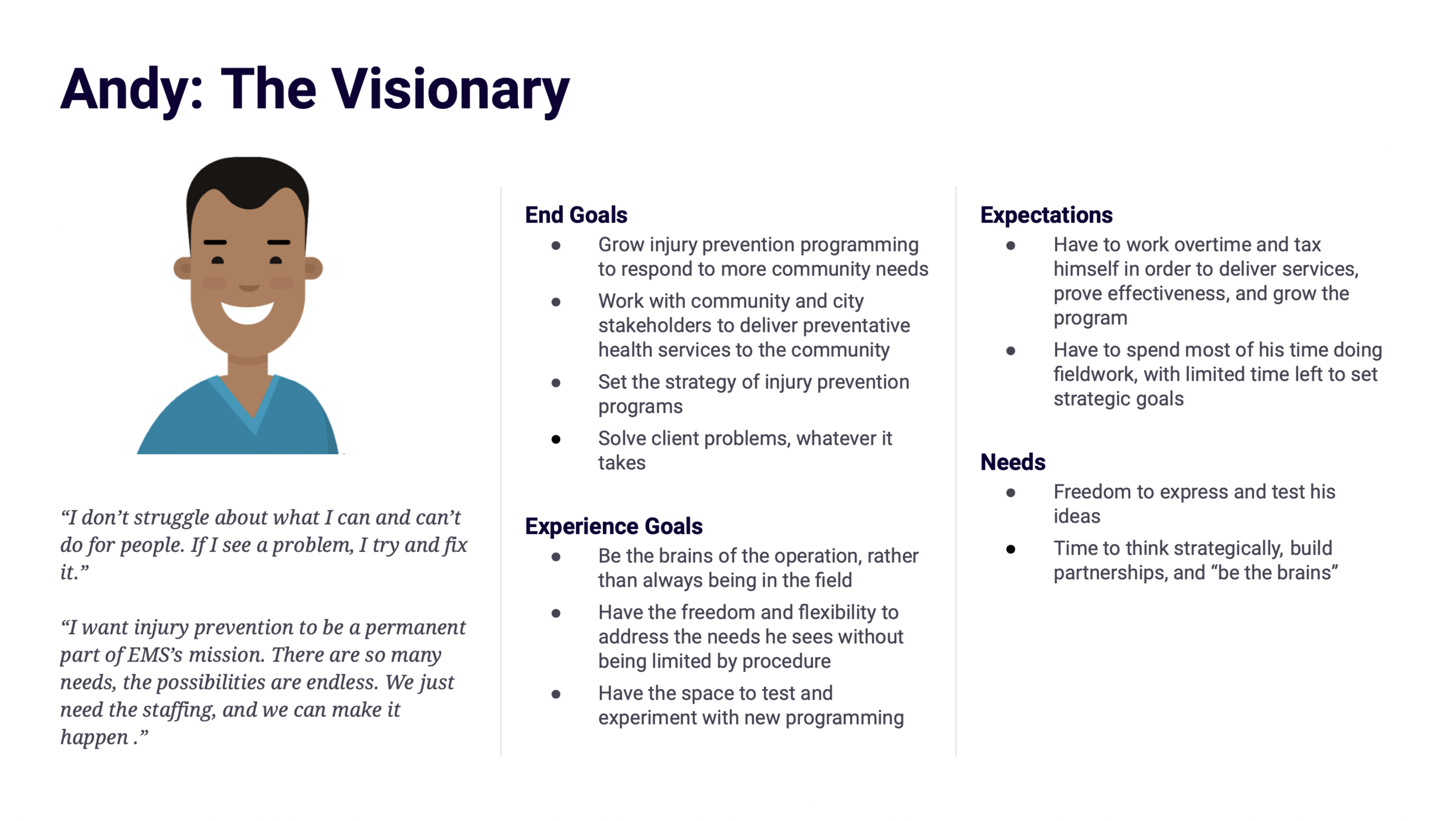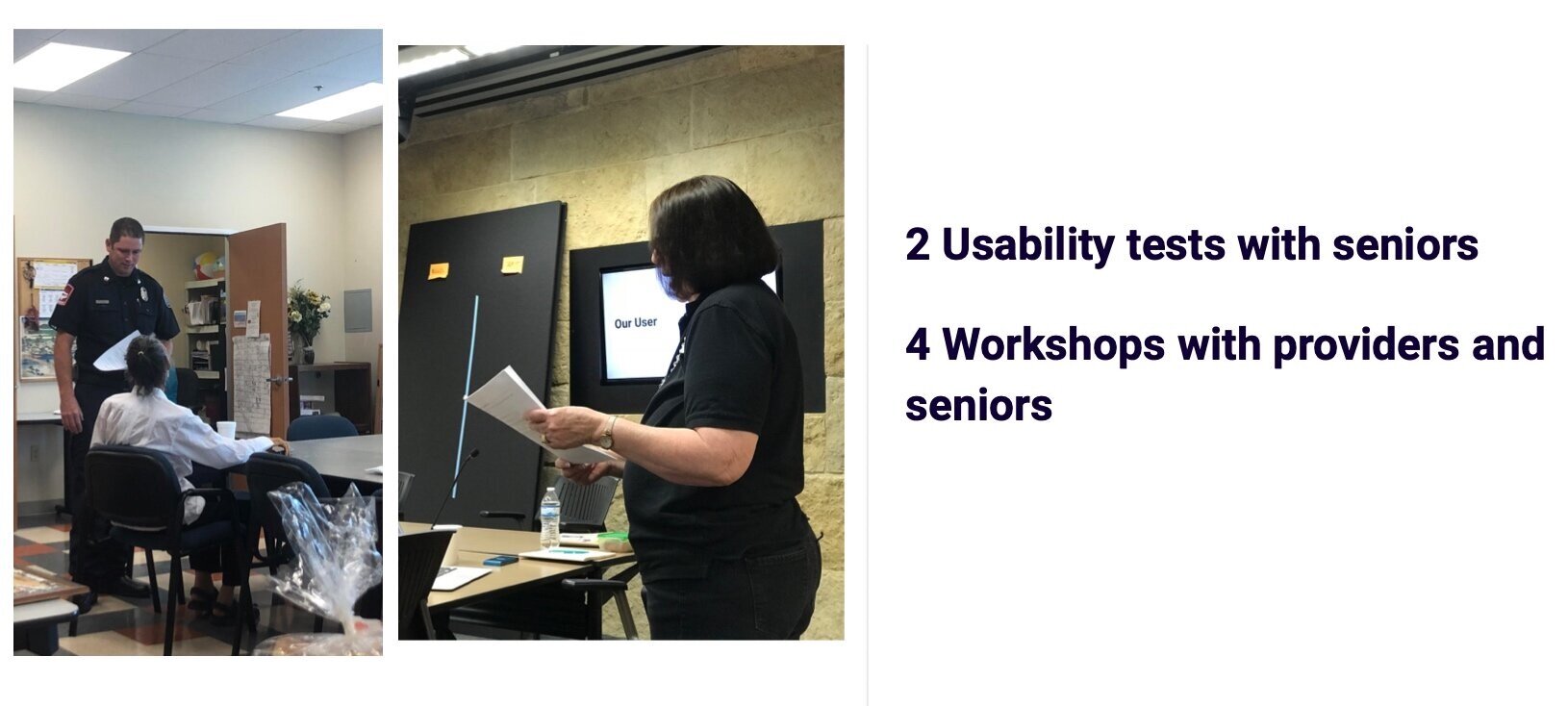Our office, in collaboration with the City of Austin’s, Emergency Management Services office (EMT), worked to understand the current pain points and obstacles that residents and EMS providers face in their “Residential Fall Prevention Program.” This initiative is a partnership between neighborhoods, the community, government, public safety, researchers, and stakeholder groups. Together we worked to develop innovative ways to deliver in home health services to residents equitably and efficiently, rather than short-term fixes, because these solutions must be sustainable over time.
Partner: Service Design Lab / Emergency Service Management / Austin Fire Dept / Residents
Duration: 6 Weeks
My Role: (Research) Interviews (foundational/usability), Workshop Creation & Facilitation, Synthesis & Ideation of data
Design: Service Blueprint, Interactive Prototype, Workshop materials,
Tools: Sketch, Invision, Google Docs-Sheets
Website: Senior Home Safety Program
Challenge presented:
How might we help the Fall Prevention Program more effectively and efficiently use the information at its disposal to connect elderly residents to the preventative health resources they need to change their behaviors?
How might we market our value proposition to medics, clients, and partners?
Project History
Elderly falls attribute to a significant amount of both dispatches and transports to the Emergency Room when compared to other traumatic call types and a large percentage of these falls occur in the home. Austin-Travis County EMS has a team of trained personnel who conduct FREE home safety assessments to identify potential risks and hazards for slips, trips and falls in the home environment. Any person who meets the following criteria is eligible for a home safety assessment:
Home safety evaluations include the following:
Home hazard mitigation to reduce fall risks
Basic strengthening and balancing activities
Medication review and Vial of Life program kit
Information about FREE safety equipment (canes, lockboxes, wheelchairs, smoke detectors)
CarFit inspection - opportunity to check how well their personal vehicles "fit" them
Methods
User Interviews
Foundational interviews were completed with residents and EMS providers. User interviews (foundational) and in the field (shadowing) were completed with both residents and EMS providers. During which we observing new residents attempting to sign up for the fall prevention service as well as the ride alongs and EMS providers delivering services like a key box, and safety inspections.
Takeaways
The program is the pipeline: building the system of preventative senior health services is what allows the Senior Health and Safety Program to serve seniors well and scale sustainably.
Everyone is reinventing the resource list wheel, and everyone suffers for it.
Inconsistent follow through causes mistrust and confirms negative assumptions.
Personas
After conducting foundational interviews as well as observing residential parking and enforcement staff in the field, as well as resident interviews sharing their experiences with parking simple personas where created to remind us who was at the table when thinking of needs from the service.
Service Blueprint
I created a service blueprint (sketch) to outline the journey of a resident in need of the Fall Prevention Program (FPP), noting methods of entry to the system to apply, from online to phone. This journey also demonstrates where the lines of interaction blur and moves into the permit providers hands, or parking enforcements. The good and bad and based on overlapping resident and worker interviews provided pain points that cause disruption within the permitting system.
Testing Assumptions
We also attempted user testing around the rebranding of the Fall Prevention Program as the “Senior Health and Safety Program.” We did this by testing the original messaging as a control at a senior center during a free lunch, then tested the new messaging at two different senior center during a different free lunch. We also conducted 4 workshops with providers and seniors on how best to make the most successful fall prevention connections. In these workshops providers shared resources, aligned on goals, and role played with a resident to understand how difficult it can be for a senior to navigate senior services successfully.
Workshopping pain points
Organized and facilitated 4, 3 hour convenings attended by 75 participants from across the provider community. During which we attempted to convene and map of all the current and potential stakeholders to build a system of senior services-Including non profits, student orgs, hospitals, clinics, city and county departments/teams, private companies. Working together to ideate and solve for particular shared problems (i.e. transportation, active seniors, hazard mitigation, assistive equipment etc.) During which we conducted a shared inventory of organizations serving seniors in Austin/Travis County
We started with hearing a user’s story, and asking questions to learn more. We framed the needs we heard in the users’, rather than clinical or organization terms.Once we had understood and prioritized the user’s needs, we matched those needs to the services that directly responded. Now that we knew what services the user needed, we had to think about who provided those services. More often than not, there was more than one provider who offered the same service.We did an analysis of each’s strengths and constraints, to decide who would be responsible for the service.
Amongst each team assigned to the different needs, we came up with a mini coordinated care plan including the services necessary, a point of contact for them, and the time frame and deadlines the senior and the providers, needed to work towards. The provider teams for each need worked together to coordinate their schedules, and provide a clear picture of the services offered, timeline, and points of contact to the user.We broke up the obstacles to collaboration we noticed into three challenges, and came up with ideas to understand, coordinate, and continuously improve service provision for seniors.







